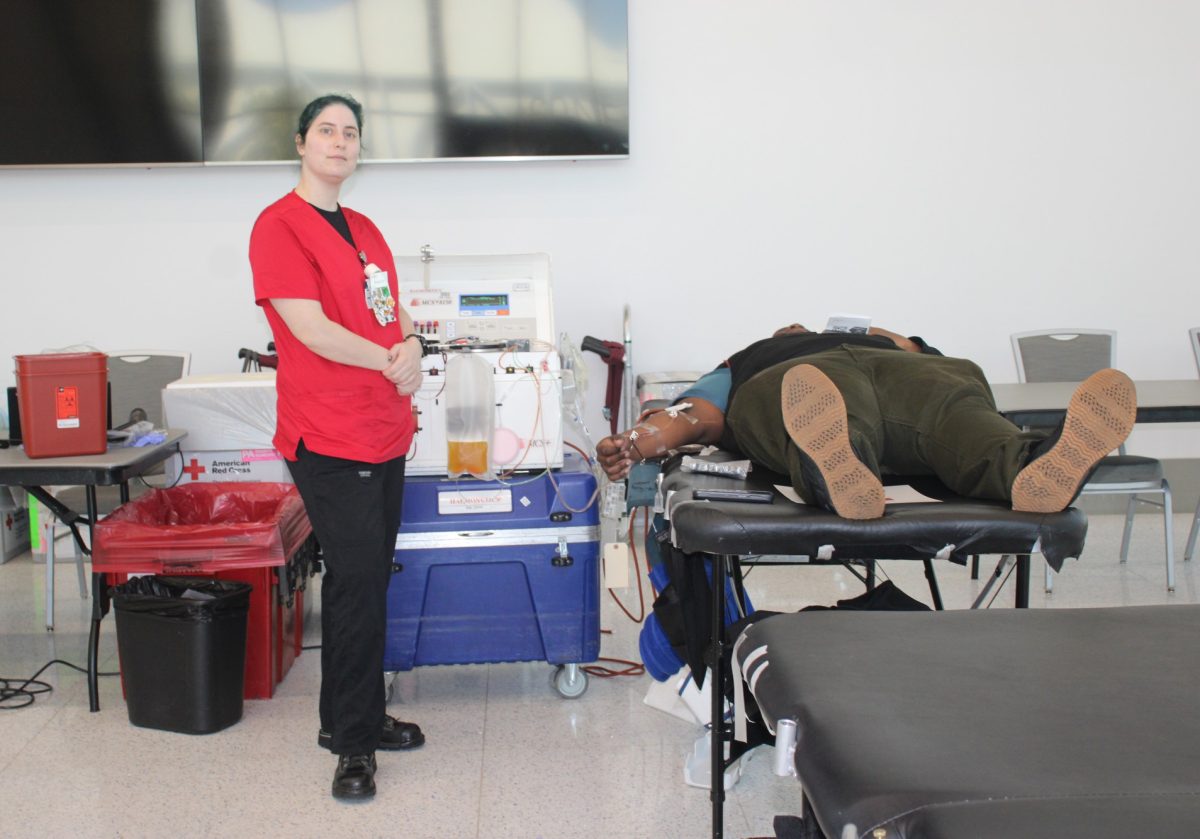
Angie Campos
Kelsey Newman preps student for a power red donation during the American Red Cross blood drive on April 7, 2025.
The American Red Cross held a two-day blood drive on April 6th and 7th located at Cerritos College’s conference center which received a strong response from students.
“This is my first time here at Cerritos, and we did about 28 units the first day,” Kelsey Newman, a representative from the American Red Cross said.
“The goal is 22 units for day two. Every donation matters because it could save three lives or more.” She pointed out that college campuses generally have a strong turnout for blood drives.
“As far as colleges go, this is a fairly good response,” Kelsey remarked.
Newman believes college students are uniquely positioned to make a difference.
“I think it teaches our younger students the importance of giving back to the community,” she explained.
She also highlighted how donating blood can help multiple people — up to three with a whole blood donation and up to six with a power red donation.
“The blood collected could be shipped anywhere in the U.S., and the need is critical. Every two seconds, someone needs blood,” Kelsey added.
Participating in blood drives also gives students a sense of purpose. By donating, they can directly impact those in need and potentially save lives.
For many young people, it becomes a meaningful way to contribute to their communities while making a real difference.
Many people are unsure about the blood donation process, and Kelsey clarified some common misconceptions, “A lot of people think we use the same needles and kits for everyone, but that’s not true. Each person gets their own kit to ensure safety and cleanliness.”
The blood is also thoroughly tested by the lab before being sent to hospitals. “Testing takes about one to two weeks, and if something shows up in the blood, we contact the donor,” Kelsey explained.
First-year Cerritos College student Joshua Cruz said, “I was nervous about donating blood, but I think the thing that got to me the most was the needle. They’re very soft with their hands so I don’t even feel the prick, so now that I donate blood, I have no fear when it comes to it.
“The process takes about 30 minutes depending on how many people there are, but it is fairly fast. And you’re lying down most of the time, so it’s very relaxing as well,” Cruz said.
She also discussed the constant demand for blood. Whether it’s for trauma patients, cancer patients, or mothers experiencing complications during childbirth, blood is needed for a wide range of medical situations. “We have to give back to help people who are sick or injured,” Kelsey stated.
For first-time donors who might be nervous, Kelsey had some helpful advice: “Drink lots and lots of water before you donate. The more hydrated you are, the easier it is for us to find your veins.”
She also reassured potential donors, reminding them that the process is quick and relatively painless. “It’s like getting a blood draw at the doctor’s office. Just take a deep breath and remember that you’re saving lives.”
Certain blood types are in higher demand than others, and Kelsey shared that O-negative blood is especially sought after. “O negative is the universal donor,” she said. “But only about 7% of the population has this blood type. It’s rare, and we always need more.”
O-positive, A-negative, and B-negative blood types are also important since they can be given to a larger number of recipients.
By taking part in blood drives, students can help meet the immediate needs of hospitals. With organizations like the American Red Cross supporting these efforts, the ability to save lives is just a donation away.
